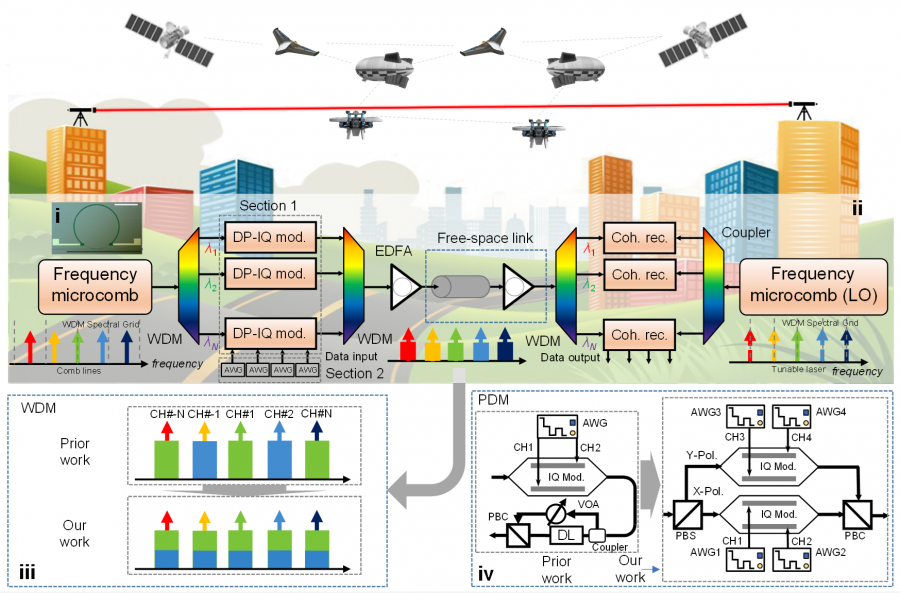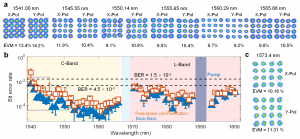
Free-space terabit/s coherent optical links via platicon frequency microcombs
GA, UNITED STATES, May 28, 2025 /EINPresswire.com/ -- Optical frequency combs technology has become a core technology in information systems over last decade. Recently, UCLA reported groundbreaking research in eLight demonstrating chip-level platicon frequency microcombs achieving free-space terabit coherent optical communication. In a 160-meter link, data transmission reached 8.21 Tbit/s and remained stable under turbulence, offering innovative solutions to meet the high-bandwidth demands of 6G networks and communications.
Breakthrough Technology: Free-Space Terabit Coherent Optical Communication Based on Platicon Microcombs Ushers in the 6G Era
Since the Nobel Prize in Physics was awarded in 2005 for the invention of optical frequency combs, they have become a core technology in information systems. An optical frequency comb consists of a series of evenly spaced frequency components with stable phase relationships and is widely applied in fields such as high-precision time-frequency science, ultra-stable microwave generation, astronomical spectroscopy, and optical communication. In recent years, the rapid development of semiconductor micro-nano fabrication technologies has spurred the fast advancement of integrated frequency combs, leading to new physical explorations and engineering solutions. Integrated optical combs are now widely used in optical computing, photonic microwaves, LiDAR, quantum optics, terahertz photonics, and other cutting-edge fields.
Recently, University of California, Los Angeles reported a groundbreaking work titled "Free-space terabit/s coherent optical links via platicon frequency microcombs" in eLight. This research demonstrated the first-ever use of chip-level Platicon frequency microcombs to achieve free-space terabit coherent optical communication. In a mixed indoor-outdoor link spanning 160 meters, the technology achieved a data transmission rate of up to 8.21 Tbit/s, remaining stable under turbulence conditions. This achievement offers a new solution to meet the high bandwidth demands of 6G networks, integrated space-air-ground-sea communications, and satellite links.
Background: Challenges and Importance of Free-Space Optical Communication
With the rapid development of 5G and future 6G networks, the demand for communication bandwidth is growing exponentially. Traditional radio frequency (RF) spectrum resources are nearing saturation. Free-space optical communication (FSO), with its high bandwidth, security, and low deployment costs, has become a key technology to break through the "last mile" bottleneck and enable the creation of a "space information superhighway." However, existing FSO systems rely on multi-laser arrays, facing challenges such as large volume, high power consumption, and complex phase synchronization, while atmospheric turbulence and pointing errors can lead to signal degradation.
Integrated microcavity optical frequency combs, which generate hundreds of phase-locked optical carriers from a single pump laser, provide an ideal platform for parallel data transmission. However, the application of traditional microcombs in free-space links has been limited by conversion efficiency and power uniformity issues. The Platicon microcomb introduced in this study successfully addresses these challenges through unique spectral shaping and efficient energy conversion.
Technical Breakthrough: Platicon Microcombs and Terabit Transmission
The research team designed a Platicon frequency microcomb based on a silicon nitride (Si₃N₄) micro-ring resonator. This microcomb generates a flat spectrum with an approximate rectangular shape via normal dispersion microcavities, covering a 12.5 THz C/L-band and containing over 55 optical carriers with a channel spacing of 115 GHz. The optical carrier-to-noise ratio (OCNR) reaches 50 dB, providing a foundation for high-density wavelength division multiplexing (WDM) and polarization multiplexing (PDM).
In the experiments, the team used 16-state quadrature amplitude modulation (16-QAM) with a symbol rate of 20 Gbaud per carrier, driving a dual-polarization IQ modulator to transmit data over a 160-meter atmospheric link. The results showed that even under turbulence-induced log-normal intensity scintillation and pointing errors, the system’s bit error rate (BER) remained below the forward error correction (FEC) threshold (4.5×10⁻³), with a spectral efficiency of 1.29 bit/s/Hz.
Innovative Highlights: Turbulence Tolerance and Carrier Phase Recovery
To mitigate atmospheric turbulence, the team developed an active beam stabilization system, reducing beam position fluctuations by a factor of 10. Additionally, they achieved the first-ever carrier phase recovery technology based on the microcomb, monitoring carrier phase fluctuations and compensating in real time for phase noise induced by turbulence.
Compared to commercial laser arrays, the Platicon microcomb generates only an additional 0.5 dB power penalty at the same BER and significantly reduces system complexity with chip-level integration.
Application Prospects: Key Support for 6G and Integrated Space-Air-Ground-Sea Networks
High-Capacity Backhaul for 6G Networks: Platicon microcombs can replace traditional multi-laser modules in base stations, providing low-cost, high-density terabit-level backhaul links for millimeter-wave and radio-over-fiber (RoF) hybrid networks.
Satellite and Ground High-Speed Interconnect: This technology is suitable for inter-satellite laser communications and low Earth orbit (LEO) satellite-to-ground transmissions, aiding in the construction of a global broadband "space-air-ground-sea" integrated network.
Emergency Communications and Drone Networks: In disaster relief or remote areas, high-speed communication can be achieved over distances of several kilometers without fiber deployment, supporting real-time collaboration in drone swarms.
Professor Wang Wenting remarked that with continuous technological progress, space information transmission has become a critical development direction for modern communication and satellite technologies. In recent years, photonic chips, as an emerging technology, are gradually becoming the core driver of the space information transmission revolution, helping to build a global space information "superhighway." The next steps will involve improving the conversion efficiency and carrier power of microcombs to support longer-distance transmission (tens of kilometers) and exploring integration with artificial intelligence-driven signal processing algorithms to further optimize spectral utilization.
Conclusion
The successful validation of space optical communication based on Platicon microcombs marks a key step towards chip-based, high-reliability free-space optical communication. As the 6G standardization process accelerates, this breakthrough not only provides a new physical-layer architecture for future networks but could also reshape the global communication infrastructure landscape.
References
DOI
10.1186/s43593-025-00082-0
Original Source URL
https://doi.org/10.1186/s43593-025-00082-0
Funding information
This work was supported by the Office of Naval Research (N00014-16-1-2094), and the National Science Foundation (1824568, 1810506, 1741707, and 1919355).
Lucy Wang
BioDesign Research
email us here
Distribution channels: IT Industry, Technology
Legal Disclaimer:
EIN Presswire provides this news content "as is" without warranty of any kind. We do not accept any responsibility or liability for the accuracy, content, images, videos, licenses, completeness, legality, or reliability of the information contained in this article. If you have any complaints or copyright issues related to this article, kindly contact the author above.
Submit your press release


